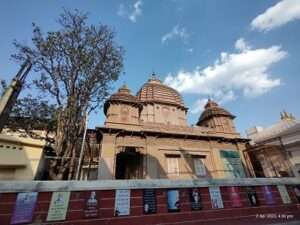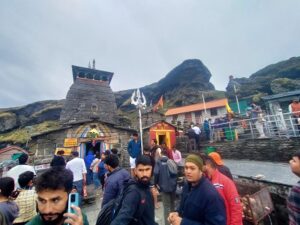You may or may not have heard of the Gundicha Temple. But the Lord of the Universe does and he along with his siblings visits the Gundicha Temple every year. There are things attached to the Gundicha Temple that you must know before you visit there. There also is a day, when you can meet the Lord of the Universe, the Lord Jagannath in this temple.
You might have guessed now what I am talking about. Yes, I am talking about the world-famous Jagannath Rath Yatra, which starts from the Jagannath Temple. The 9 days of this ancient festival start with a procession heading towards Gundicha Temple and reside there for the first 7 days. They the deities leave for the Mausi Maa Temple and return back to Jagannath Temple on the 9th day.
Why is Gundicha Temple so special?
On the grand occasion of Jagannath Rathyatra, Lord Jagannath along with Lord Balbhadra, Goddess Subhadra and Sudarshana visit the Gundicha Temple. The Rath Yatra of Jagannath Puri is so famous that it attracts lakhs of pilgrims and devotees every year. But why this temple only? There are various temples even on the premises of Jagannath Temple. Then why the procession of Rath Yatra visits the Gundicha Temple only?
History of Gundicha Temple
Before knowing the why, let’s know whose temple is this. Devi Gundicha is the Queen of King Indradyumn. She was a great devotee of Lord Jagannath. Once she requested the King to build a home inside a garden. Later on, this temple became popular as Gundicha Temple and is also known as the Garden House of Lord Jagannath.
Why Lord Jagannath visits the Gundicha Temple every year?
There are many stories about Lord Jagannath visiting the Gundicha Temple.
- Gundicha Devi was a great devotee of Lord Jagannath. Considering her devotion, Lord Jagannath promised her to come here on the occasion of Rath Yatra every year. Since then, Lord Jagannath with other deities come here on the occasion of Jagannath Rath Yatra on the 2nd day of Shukla paksha.
- Another story is that Gundicha was like an aunt to Lord Krishna and hence he used to come with his siblings here.
- One of the stories also tells that after taking a bath from 109 buckets of water, Lord Jagannath fell ill and got a fever. So, when they got well, Devi Gundicha wanted to meet them and hence requested to come to their home.
Gundicha Yatra or Rath Yatra
A very popular religious procession and one of the most awaited festivals not only in Odisha but in the whole country Jagannath Rath Yatra is celebrated in the month of June or July. Dedicated to Lord Jagannath, a form of Lord Vishnu, his sister Goddess Subhadra and his elder brother Lord Balabhadra who is also known as Balram.
Rath is a hindi word which translated to a chariot in English. This Rathyatra is one of the oldest ones in the entire human civilazation. As per the Oriya Calendar, this Rathyatra is celebrated on the 2nd day of the Shukla paksha.
Various Names of Jagannath Yatra
Jagannath Rathyatra is also known by various names such as Gundicha Yatra, Car Festival, Dasavatara, and Navadina Yatra. Dasavatara because of the 10 incarnations of Lord Vishu who is Lord Jagannath. Jagannath means the lord of the universe. And Navadina Yatra because it lasts for 9 days.
The Procession
The Jagannath Yatra starts with a procession known as Rathyatra heading towards the Gundicha Temple from the Jagannath Temple. While all four deities reside in the Gundicha Temple for the next 7 days.
Bahuda Yatra
On the 8th day, all the deities return to the original Temple and now this is called the Bahuda Yatra. During Bahuda Yatra the deities visit the Mausi Maa temple first. On the 9th day Jagannath Yatra festival, all four deities return to Jagannath Temple finally.
Features of the Chariots
All four deities have their own chariots. Nandighosa is the chariot of Lord Jagannath with 18 wheels and a height of 45.6 feet. Taladhwaja’s height is 45 feet and has 16 wheels which Lord Balbhadra moves. Devi Subhadra has a chariot named Dwarapadalan with 14 wheels and a height of 44.6 feet.
To carry these huge chariots to the Gundicha Temple and back to Jagannath Temple, devotees use 50m ropes. Although the distance between both these temples is just 3 km the devotees in the passion of devotion forget everything and submerge in their affection for their dear God and it takes several hours to pull the chariots to Gudicha Temple.
History and Legends of Rath Yatra
- The Jagannath Puri Rathyatra is considered to be one of the oldest religious festivals in the world. Historical Texts like Skanda Purana or Brahma Purana and even Mahabharata mention puri. Although, it is not exactly clear when did this festival start yet there are many stories attached to the festival.
- Historical texts like Mahabharata mentions the story of Krishna killing his evil maternal uncle Kansa. So, the story says that the Jagannath Yatra is a depiction of Lord Krishna who is also Jagannath moving to Mathura from Vrindavan to end the suffering of the people.
- Another story is about how all four deities got a fever and then after recovering from it, they went to meet their aunt, Gundicha Mata. There is one more story which tells that once Lord Jagannath wanted to meet his devotees and that is why he with his siblings came out of his home and this Rathyatra is a depiction of that.
Chariots of Rathyatra
The Cahriots are the main attraction in the procession of the Jagannath Rathyatra. All four deities have their own chariots.
As you already read their names are Nandighosa, Taladhwaja and Dwarapadalan. All four Chariots are pulled by hundreds of devotees using 50 meters ropes.
The beauty of these chariots is that they are constructed with the help of thousands of years old techniques and no modern-day equipment or methods are used even today. Artists decorate these chariots using designs, and motifs and paint beautifully.
Pulling the roped-off the Chariots is considered to be very sacred and sin-relieving. One who even gets to touch the rope receives the benefit of many virtues.
Procession of Rath Yatra
Several days prior to the Rath Yatra, all the deities are bathed with water. No, with 109 buckets of water. Due to this, they get a fever and hence are left in isolation to recover from it till the date of the procession. This whole process is termed Ansara.
When the date of the procession comes, the deities are dressed up with wood, clothes and raisins. This may sound very unfamiliar as most of the other deities wear gold ornaments and the idols are made up of precious metals.
Chhera Pahara
The Royal Successor of Odisha is obliged to perform the rituals of Chhera Pahara. It is performed just before the beginning of the procession. Or you say that it is the preparation to begin the Jagannath Rath Yatra procession. Even this year it will be continued as always.
The Beginning of the Procession
So the successor along with all the devotees flock around the temple area. The royal successor cleans the chariots with their hands using a broom with golden handles. He also cleans the way on which the chariots will be pulled and sprinkles sandalwood all over the way to the Gundicha Temple. Then the deities are taken out from the temple and this will only be done by the king himself. The deities are then placed on the chariot and decorated with flowers.
The king does not perform it because he is the king and he has the privilege to do it. It is because people chose him as their representative otherwise each and every single being is considered equal in the eyes of Lord Jagannath and his devotees.
Generally, the Jagannath Temple only welcomes people of the Hindu faith but on Rathyatra any human being
can visit the temple and take blessings from Lord Jagannath.
The Delicious Poda Pitha
The deities visit their aunt Mata Gundicha and stay there for the first 7 days then they leave for the Mausi Maa Temple where they are served the Poda Pitha. It is like a sweet pancake but was delicious. A Poda Pitha is considered to be the cheapest food by the devotees. Hence, it is a denotation that to offer something to Lord Jagannath you don’t need to be rich and wealthy. For Lord Jagannath, Poda Pitha is the most delicious dish on the earth.
Suna Vesa
When the deities return to the Jagannath Temple, they wait outside the sanctum sanctorum. The very next day, the idols are decorated with new clothes like babies. Suna Vesa is the event of dressing up the deities. After that, the deities enter the sanctum sanctorum of the Jagannath temple and end the grand Rath Yatra of Jagannath puri.
Where is the Jagannath Rath Yatra celebrated?
This grand festival of Jagannath Rath Yatra is enthusiastically celebrated in Puri, a city in Odessa. Rath Yatra is performed at the Jagannath Temple in Puri which is merely 60 km from the capital city of Odisha, Bhubaneshwar. The Jagannath Temple is 1.7 km from Puri, 70 km from Bhubaneshwar, 84 km from Cuttack and 1800 km from the capital of India; Delhi.
History of Jagannath Temple
The Jagannath temple in which all four deities respectively, Lord Jagannath, Goddess Subhadra and Lord Balbhadra reside was built in the 12 century AD. Historically the Jagannath Temple was built by Chodaganga Dev of the Ganga Dynasty and improvised by later kings.
Rath Yatra 2023
This year in 2023, the very auspicious Jagannath Rath Yatra is going to be held in the English month of July. This month on the 20th of July is the beginning of Rath Yatra or Gundicha Yatra.
In the Hindu Calendar, it is the month of Ashadh. On the 2nd day of Shukla paksha in the month of Ashadh, the Jagannath Yatra will be celebrated this Year.
Dress Code of Jagannath Rath Yatra
Many people search if there is a dress code to participate in the Rath Yatra of Jagannath. So, there is no such dress code for the same. Yet, it is obvious that traditional dresses are best for this purpose. Consider wearing a dress which covers your shoulders and knees, by doing so you also respect the religious sentiments of the locals.
What to expect in Jagannath Puri Rath Yatra?
Being one of the oldest, most awe-inspiring and most dignified festivals in Odisha, Jagannath Rath Yatra has a lot of awe-struck moments to offer to everyone. The Jagannath Rathyatra attracts more than 4 lakhs of pilgrims from every corner of the world every year.
Highlights of Jagannath Rath Yatra Festival
- The festival lasts for 9 days during which Lord Jagannath with his siblings visit the Gundicha Temple and the Mausi Maa Temple.
- Grand Chariots are built like the replicas of the temple itself which are pulled by hundreds of devotees on the Badadanda Street in Puri.
- On the auspicious day of Rath Yatra, even people from different faiths and religions are allowed to take a glimpse of Lord Jagannath and enter the temple.
- Devotees play the drums, trumpets and other instruments making the procession look very dynamic and grand.
Timings of Jagannath Puri Temple
- 5:30 AM to 10 pm every day
Top Places to visit near the Jagannath Temple in Odisha
These are some of the best places you can consider visiting in Odisha.
- Puri Beach
- Konark Temple
- Konark Beach
- Raghurajpur artist village
- Chilika Lake
- Sakshi Gopal Temple
- Pipli village
- Shree Loknath Temple
- Gundicha Temple
- Mausi Maa Temple
Here is a budget Trip Itinerary to Puri that you might like
Day 1:
Delhi – Puri – Jagannath Temple – Puri Beach
- Depart from Delhi to Puri by overnight train, which is generally more economical than flights.
- Cost: Approximate train ticket price from Delhi to Puri: Rs800-Rs1200 per person.
- Arrive in Puri and check into a budget-friendly guesthouse or hotel.
- Cost: Average budget guesthouse price in Puri: Rs1200-Rs1600 per night for a double room.
- Visit the Jagannath Temple and enjoy the spiritual ambience. Remember that entry to the temple is free, but donations are appreciated.
- Cost: Free (donation optional).
- Explore Puri Beach and enjoy the scenic beauty.
- Cost: Free.
- Overnight stay in Puri.
Day 2:
Konark Sun Temple – Chandrabhaga Beach
- Start your day by visiting the Konark Sun Temple. Opt for local transportation like buses or shared autos to save on costs.
- Cost: Bus fare from Puri to Konark: Rs80-Rs160 per person (round trip).
- Cost: Entry fee for Indian nationals: Rs160 per person.
- Cost: Entry fee for foreign nationals: Rs800 per person.
- Spend the day at Chandrabhaga Beach, where you can relax and enjoy the serene surroundings.
- Cost: Free.
- Have an affordable meal at local eateries or try street food options.
- Cost: Approximate cost for meals per day: Rs800-Rs1200 per person.
- Return to your accommodation and relax in the evening.
- Cost: Free.
- Overnight stay in Puri.
Day 3:
Market Hopping – Chilika Lake – puri Beach Aarti
- Explore the local markets and bazaars of Puri, such as Swargadwar Market and Puri Market, where you can find reasonably priced souvenirs and local products.
- Cost: This varies depending on your shopping preferences.
- Visit the Puri Beach Market and enjoy local snacks and crafts.
- Cost: This varies depending on your shopping preferences.
- Take a budget-friendly boat ride on Chilika Lake. Look for shared boat options or negotiate prices to get the best deal.
- Cost: Boat ride prices vary depending on the negotiation and the type of boat chosen.
- Witness the Puri Beach Aarti in the evening.
- Cost: Free.
- Depart from Puri to Delhi by overnight train.
- Cost: Approximate train ticket price from Puri to Delhi: Rs800-Rs1200 per person.
Overall approximate cost for the trip (excluding accommodation): Rs4000-Rs6000 per person.
Please note that the prices mentioned are approximate and can vary based on factors like season, availability, and personal preferences. It’s recommended to research and confirm the prices and availability of accommodations, transportation, and attractions beforehand. Enjoy your budget-friendly trip to Puri!
Takeaways
Gundicha Temple is one of the most important temples in Odisha. During Rath Yatra, Lord Jagannath with other deities visit the Gundicha Temple. On this day, you can meet Lord Jagannath in the Gundicha Temple.
Devi Gundicha requested King Indradyumn to create a house in the middle of a garden for Lord Jagannath. Since then it is also called the Garden House of Lord Jagannath.
Rath Yatra is one of the oldest living festivals in the human civilization. It attracts Lakhs of pilgrims from around the world.
Rath Yatra is the festival when the deities leave their original abode once a year.
Rath Yatra is also known as Gundicha Yatra as deities visit the Gundicha Mata Mandir leaving their original abode. Devi Gundicha was a strong devotee of Lord Jagannath and hence built this temple for him.
Chariots of the Yatra are the main attraction of Rath Yatra. There are different chariots for different deities. They have different names and different features.
Nandighosa, the chariot of Lord Jagannath has 18 wheels and a height of 45.6 feet.
Taladhwaja has a height of 45 feet and has 16 wheels and belongs to Lord Balbhadra moves.
Devi Subhadras’ chariot named Dwarapadalan has 14 wheels and a height of 44.6 feet.
Poda Pitha is one of the most delicious dishes of Odisha. It is a must to try dish in Odisha. It is similar to a sweet Pancake.
The grand festival of Rath Yatra is celebrated in the city of Puri, Odisha. 60 km from Bhubaneshwar, Rath Yatra is celebrated at the Jagannath Temple on the Badadanda Street of Puri.
This year in 2023, Rath Yatra will begin on the 20th of July.
The Jagannath Temple is open for devotees from 5:30 am in the morning till 10 pm at night.


